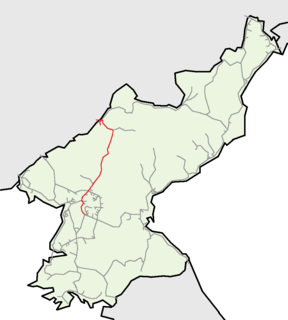
The Gyeongin Line (Gyeonginseon) is a railway mainline in South Korea, currently connecting Guro Station in Seoul and Incheon. Commuter services along the line through operates into Seoul Subway Line 1.

The Gyeongwon Line is a railway line serving northeastern Gyeonggi Province in South Korea. The line is operated by Korail. The name of the line came from Gyeongseong (Seoul) and Wonsan, the original terminus of the line, in what is now North Korea.

The Pakch'ŏn Line is a former non-electrified standard-gauge secondary line of the Korean State Railway in Pakch'ŏn County, North P'yŏngan Province, North Korea, running from Maengjungri on the P'yŏngŭi Line to Pakch'ŏn.

The P'yŏngbuk Line is an electrified standard-gauge secondary trunk line of the Korean State Railway in North Pyŏngan Province, North Korea, running from Chŏngju on the P'yŏngŭi Line to Ch'ŏngsu; it meets the Ch'ŏngnyŏn P'arwŏn Line at Kusŏng, and at Ch'ŏngsu, via a bridge across the Yalu River, it goes to Shanghekou, China, where it connects to China Railway's Fengshang Railway to Fenghuangcheng.

The P'yŏngdŏk Line is an electrified standard-gauge trunk line of the Korean State Railway in North Korea running from Taedonggang Station in P'yŏngyang, where it connects to the P'yŏngbu, P'yŏngnam, P'yŏngra and P'yŏngŭi Lines, to Kujang, where it connects to the Manp'o and Ch'ŏngnyŏn P'arwŏn Lines. The total length of the line is 192.3 km (119.5 mi).

The Kangdŏk Line is an electrified standard-gauge secondary line of the North Korean State Railway running from Namgangdŏk on the P'yŏngra Line to Susŏng on the Hambuk Line.

The Manp'o Line is an electrified standard-gauge trunk line of the North Korean State Railway running from Sunch'ŏn on the P'yŏngra Line to Manp'o on the Pukpu Line. The line continues on from Manp'o to Ji'an, China.

The Kangwŏn Line is a 145.8 km (90.6 mi) electrified standard-gauge trunk line of the Korean State Railway of North Korea, connecting Kowŏn on the P'yŏngra Line to P'yŏnggang, providing an east–west connection between the P'yŏngra and Ch'ŏngnyŏn Ich'ŏn lines.
The Ryongsŏng Line is an electrified standard-gauge secondary line of the Korean State Railway in P'yŏngyang, North Korea, running from Sŏp'o on the P'yŏngŭi Line to Tongbungri on the P'yŏngra Line. From Ryongsŏng, this line also has a line connecting to the private railway station attached to Residence No. 55, the primary residence of Kim Jong-un. The maintenance facilities for the North Korean leaders' trains are also located at Ryongsŏng Station.
The Korean State Railway (Kukch'ŏl) operates a wide variety of electric, diesel and steam locomotives, along with a variety of electric multiple unit passenger trains. Kukch'ŏl's motive power has been obtained from various sources. Much, mostly steam and Japanese-made electric locomotives, was inherited from the Chosen Government Railway, the South Manchuria Railway (Mantetsu) and various privately owned railways of the colonial era. Many steam locomotives were supplied by various communist countries in the 1950s, including the Soviet Union, Czechoslovakia, Hungary, Poland, Romania, and China.

The Toshiba DeRoI-class was a group of nine boxcab-style electric locomotives with regenerative braking and the capability for multiple-unit control manufactured by built by Toshiba in 1943-44. They were very similar to the Mitsubishi-built DeRoI-class locomotives and the DeRoNi-class locomotives built by Hitachi. They were built for the Chosen Government Railway (Sentetsu), and after the partition of Korea were inherited by the North Korean State Railway, where they were known as the Chŏngiha class.

The DeRoNi-class was a group of four boxcab-style electric locomotives with regenerative braking and the capability for multiple-unit control manufactured by Hitachi in 1943-44, very similar to the Toshiba-built DeRoI and the Mitsubishi-built DeRoI-class locomotives.

The Mitsubishi DeRoI-class was a group of three boxcab-style electric locomotives with regenerative braking and the capability for multiple-unit control manufactured by Mitsubishi in 1946. They were very similar to the Toshiba-built DeRoI-class locomotives and the DeRoNi-class locomotives built by Hitachi. They were built for the Chosen Government Railway (Sentetsu), but the war ended before delivery took place. They were delivered to the Korean National Railroad after the partition of Korea, which designated them 데로3 ("Dero3"). During the Korean War all were captured by the Korean Peoples Army and taken to North Korea, where they were put into service by the Korean State Railway as the Chŏngisŏ class.
The Ch'ŏngjinhang Line, or Ch'ŏngjin Port Line, is an electrified freight-only railway line of the Korean State Railway in North Korea, connecting Ch'ŏngjin Ch'ŏngnyŏn Station at the southern junction of the P'yŏngra and Hambuk lines with Ch'ŏngjin Port.
The Ch'ŏnnae Line is an electrified 4.4 km (2.7 mi) long railway line of the Korean State Railway in Kangwŏn Province, North Korea, connecting Ryongdam on the Kangwŏn Line with Ch'ŏnnae.

The Kangan Line, also spelled Kang'an Line, is a non-electrified standard-gauge freight-only secondary line of the Korean State Railway located entirely within Sinŭiju-si, North P'yŏngan Province, North Korea, running from Sinŭiju on the P'yŏngŭi Line to Kang'an.
The Amrokkang Line is a non-electrified freight-only railway line of the Korean State Railway in North P'yŏngan Province, North Korea, running from Pup'ung on the P'yŏngbuk Line to Amrokkang Station on the Yalu River.

The Sup'ung Line is an electrified railway line of the Korean State Railway in North P'yŏngan Province, North Korea, running from Pup'ung on the P'yŏngbuk Line to Sup'ung.
The Ryongmun T'an'gwang Line, or Ryongmun Colliery Line is an electrified railway line of the Korean State Railway in Kujang County, North P'yŏngan Province, North Korea, running from Ŏryong on the Manp'o Line to Ryongmun Colliery.















